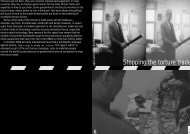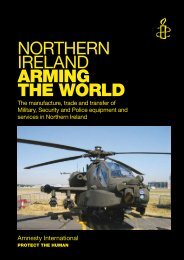CROWD CONTROL TECHNOLOGIES - Omega Research Foundation
CROWD CONTROL TECHNOLOGIES - Omega Research Foundation
CROWD CONTROL TECHNOLOGIES - Omega Research Foundation
Create successful ePaper yourself
Turn your PDF publications into a flip-book with our unique Google optimized e-Paper software.
By 1994 this work was well on its way to completion and President Clinton was able to say, )I<br />
will..direct the Office of the Secretary of Defense to accelerate efforts to field non-chemical, non-lethal<br />
alternatives to Riot Control Agents for use in situations where combatants and non-combatants are<br />
intermingled(. 336 By 1998 other paralysing tunable weapons for layered defence and less-lethal area<br />
denial munitions were selected for funding - including overhead chemical agent dispensers and rocket<br />
delivered micro-enscapsulated malodourous substances. 337 Future non-lethal weapons identified by<br />
the US Marines for 2000 onwards include pulsed energy systems, microwave systems, advanced<br />
delivery robototics and unmanned vehicles carrying less-lethal weapons etc. 338 A few examples of what<br />
has emerged already are discussed below. Some attempt has been made to say which technologies<br />
are now available, which are on the horizon or at prototype stages and which lie some years off but for<br />
which preparatory research programmes are already in place.<br />
6.3.2 Upgrades of Existing Crowd Control Technologies Much of what has been promoted for nonlethal<br />
munitions has been around in various guises for some time. In 1995, the US Joint Non-Lethal<br />
Weapons working Group had tested various off the shelf candidates including blunt impact devices,<br />
chemical irritants, entanglements and aqueous foam barriers. Fiscal Year (FY) 1995 Non Lethal<br />
accomplishments were identified by Charles Thornton, Division Chief of the Dismounted Battle<br />
Laboratory, TDADOC as blunt impact (12 gauge muzzle launched 37/40mm); chemical irritants such<br />
(such as OC & CS and what he calls RCAs) Disorientating Techs Set beam and Maxi-beam(these are<br />
dazzling light torches) entanglements; barriers - aqueous foam; 40mm sponge grenades, soft<br />
munitions and ballistic entanglements. BY FY 1996, technologies listed still included blunt impact,<br />
entanglements, slippery barriers and sticky foam but also alternatives to land mines<br />
(CALTROPS/Volcano), distraction devices and acoustic weapons. 339 Also in 1996, the US Army<br />
<strong>Research</strong> Laboratory was developing a Variable Velocity Rifle System which allows the operator to<br />
select between lethal and non-lethal on a shot by shot basis using so called dual purpose bruiser<br />
ammunition. (This device works by a venting system which keeps padding around the sabot style<br />
ammunition during low velocity firings which is released at higher more lethal speeds). 340 At the same<br />
time, the Federal Bureau of prisons was looking at off the shelf candidates for prison riot control such<br />
as chemicals, OC, smoke, flash-bang grenades, electronic stun belts and some future applications<br />
such as anaesthetic darts/pellets. 341<br />
6.3.3 Entanglements - popularly known as stickem and slickem. By 1997, after several TV and<br />
magazine articles on less-lethal weapons, the image of the sticky foamed target of a glue gun had<br />
become almost the symbol of the 2 nd . Generation of less-lethal weapons. Net guns used for personal<br />
capture are now in operational use. For example police in Western Australia recently ordered them. In<br />
1997 342 Alliant Tech, better known for making mines, made an industry perspective on non-lethal<br />
weapon systems which looked at spider net entanglements, foams to block an area and super slippery<br />
substances which make roads and pathways impassable. 343 However, at the same conference, Hilda<br />
Libby no longer talked of sticky foam as a stick em - it was seen more as an area denial munition.<br />
Why? Because despite the massive Public Relations exercise promoting its benign use to paralyse<br />
targets, it took hours to decontaminate a subject from the foam (using baby oil) and there is a real risk<br />
of suffocation if the foam covers the mouth and nose. Little is being said about such failures. Likewise a<br />
dart weapon for prisons has also apparently been quietly dropped after fears about lethal effects<br />
emerged. 344<br />
6.3.4 Directed Energy Weapons - These weapons have created the most heated debate. Some<br />
variants such as isotropic radiators have come on to the market as omni-directional laser bright<br />
rounds, where precision targeting is impossible. They are being promoted as cheap dazzle devices<br />
against people and optics but little has emerged in the way of technical data. Other more directional<br />
lasers have been used as dazzle devices for example the USAF Saber 203 laser dazzle system,<br />
prototypes of which were used by the US Marines in Somalia. 345 Blinding laser weapons are banned by<br />
the blinding laser convention, 346 nevertheless, even after this treaty, their use is still being promoted for<br />
law enforcement. 347 A recent development has been using a UV laser which can ionize the air<br />
sufficiently for it to conduct an electric charge. This enables an electric shock to be delivered over some<br />
lii




